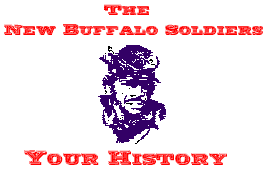 �
�
Number 1: The Early Years
The Black troops of the Ninth and Tenth Cavalry
patrolled the high plains of the Old West for over fifty years
One day in September 1867, while protecting workers of the Kansas
Pacific Railroad, forty troopers fought three hundred Cheyenne
Indians. On January 9, 1918, Troop E of the Tenth Cavalry engaged
a well armed band of Yaqui Indians in Bear Valley Arizona. Between
these years, Black Troopers fought Cheyenne and Arapahos on the
Plains, and were instrumental in subduing the Apache led by Victorio
and Geronimo in the Southwest.
By the end of the Civil War, there
were almost 180,000 African-Americans soldiers in the service
of the United States comprising 166 regiments; 145 of infantry,
7 cavalry, 12 heavy artillery, 1 of light artillery and 1 of engineers1
. Following the war there was a drastic reduction in troop strength.
However, there were several other factors to be considered. Service
in arms of the African-American was never as involved as in the
Civil War. However, there had no prior use of African-American
soldiers in peacetime, so the peacetime use of black troops was
an experiment. Additionally, while the North and South went at
each other during the Civil War, there was increasing hostilities
along the borders with Mexico and with Native Americans.
On July
28, 1866, Section 3 of An Act to increase and fix the Military
Peace Establishment of the United States, stated ..."That
to the six regiments of cavalry now in service there shall be
added four regiments, two of which shall be composed of colored
men..." Shortly thereafter in August, General U.S. Grant
directed his commanders; Gen. Philip Sheridan of the Division
of the Gulf and Gen. William T. Sherman of the Division of the
Missouri to raise a regiment of black cavalry in their respective
commands. On September 21, the 9TH and 10th cavalry regiments
were activated2. The 9th under the command of Edward Hatch in
Greenville, Louisiana and the 10th under Benjamen Grierson at
Fort Leavenworth, Kansas.
Both Hatch and Grierson had exemplary
Civil War records. Recruitment was less than optimal. Hatch's
problems were an inadequate selection pool of white officer's
to the point that there was only one officer per company (troop)
in the regiment. There were outbreaks of disease, poor morale
and a lack of discipline due to officer shortages. By March the
9TH was transferred to San Antonio. Along the way there was a
near mutiny involving several troops, resulting in the death of
one officer and two troopers3. Grierson on the other hand had
fewer potential recruits in Kansas causing him to go the big cities
on the East coast in his search for troopers. In addition there
was conflict at Fort Leavenworth, with the commanding officers,
poor equipments and broken down horses. Troop A was sent West
in February 1867, with Troops B and C following over the next
several months. He was so anxious to leave Leavenworth, that he
ordered D Troop to organize at Fort Gibson, Indian Territory.
In August, having field 8 troops, Grierson was transferred to
Fort Riley, Kansas, where the remaining 4 troop were formed. Thus
began a 20 year history of service for the Buffalo Soldiers in
the Indian Territories.

© 2000-2001 by Dr John Productions
The New Buffalo Soldiers
Shadow Hills, CA.
All rights reserved.

